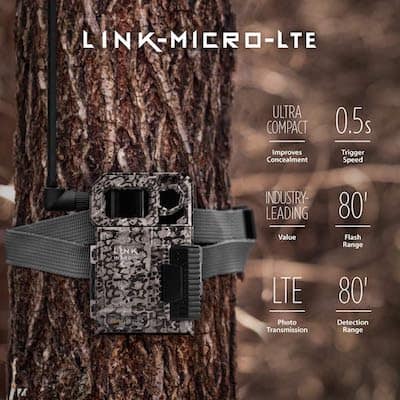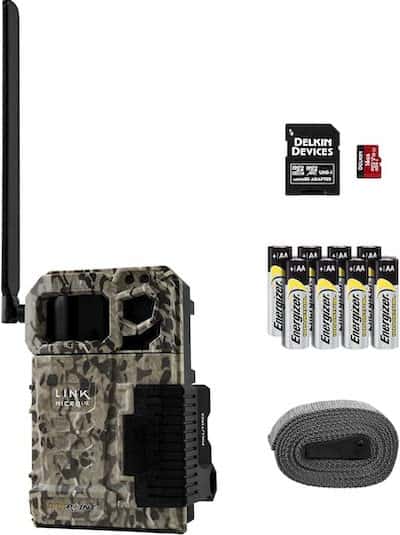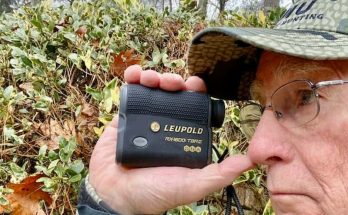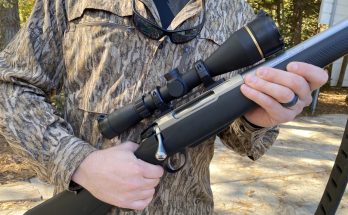SPYPOINT Link-Micro-LTE premium Cellular Trail Cameras pack $69 at AMAZON
Spypoint Cellular Trail Camera Review: SPYPOINT Link-Micro-LTE premium Cellular Trail Cameras pack includes 8 AA batteries and a 32g MicroSD card. Our LINK-MICRO-LTE offers not only cutting-edge camera performance, but it is also where you can access the tools and features that make SPYPOINT the mobile scouting solution.
ULTRA-COMPACT DESIGN: SPYPOINT LINK-MICRO-LTE Trail Camera Cellular is remarkably small for any trail camera, but even more so when you consider it is a cellular camera. This design makes the LINK-MICRO-LTE easy to conceal and keeps wary eyes from spotting the deer camera.
REDUCE HUMAN IMPACT: Nothing impacts the game you hunt more than human pressure. Moving your scouting deer cameras strategy to a cellular approach allows you to visit your hunting areas less, thereby reducing the stress on the animals that live there.
MOBILE SCOUTING SOLUTION: SPYPOINT Trail Camera Cellular delivers the definitive mobile scouting solution for the modern hunter. SPYPOINT gives you the advanced scouting tools that help you analyse that data to establish patterns and a plan to be successful.
EASY TO UNDERSTAND PHOTO TRANSMISSION PLANS: SPYPOINT also offers the $10 TRULY UNLIMITED plan. You can choose the carrier model that provides the best service where your device is placed, regardless of your personal service carrier. Trail Camera sends picture to cell phone.
LINK-MICRO-LTE SPEC’S
PYPOINT Link-Micro-LTE premium Cellular Trail Cameras pack $69 at AMAZON

SPYPOINT LINK-MICRO-LTE pairs the most popular cellular trail camera in years, with the ultra-reliable LTE cellular network. The LINK-MICRO-LTE is a remarkably compact and affordable cellular trail camera, challenging traditional expectations of performance and value the hunter can expect from a camera.
No cellular trail camera delivers more for less. SPYPOINT LINK-MICRO-LTE; the biggest value in cellular game cameras, brings the most exciting and innovative hunting technology of the last decade to a point that any hunter can appreciate.
EASE OF USE

SPYPOINT LINK-MICRO-LTE offers the perfect balance of cellular technology and a simplified platform, unburdened by complicated features. This balance can be appreciated by both tech-savvy hunters, and those new to cellular trail camera technology.
- 1) Choose the carrier model that offers the best coverage at your hunting location
- 2) Download the SPYPOINT mobile app
- 3) Follow the easy “activate new camera” prompt in the app
- 4) Install SD card and batteries
- 5) Power on camera
- 6) Start receiving photos
AVCMOTO Game & Trail Camera Mount, Trail Camera Stand

AVCMOTO Game & Trail Camera Mount $39 at Amazon
Trail Camera Stand, 360 Degree Adjustable Universal Screw Connection 1/4”-20 (6mm), for Night Fishing Lights, Solar Panels, etc. (3 Pack)
Game & Trail Camera Mount threaded head angle can be adjusted at will, stainless steel bracket length adjustable, lift adjustable. The trail Camera Mount tripod plug can be inserted into the ground stably, and the thick stainless steel material provides excellent stability and durability.
【360°Rotation】 Versatile 1/4”-20 (6mm) threaded head supports one camera or one solar panel, flexible camera positioning with 360 degree rotation and adjustable tilt angle of any angle, adjust at will according to your preference.
Spypoint Cellular Trail Camera Review – Transmission Plans
From camera management to advanced scouting options, the SPYPOINT hunting & trail cameras experience truly is the definitive mobile scouting solution. As the only company to offer both a free, and unlimited plan, the SPYPOINT photo transmission plans are the easiest to understand, and most affordable plans you can find.
Some of my cameras have an annual subscription and some have monthly. You choose your plan for each camera. You also get 100 photos sent to your phone free or use the camera without a plan.
Spypoint Cellular Trail Camera Review – The App
Choose the advanced scouting tools that fit the way and seasons that you hunt, so you know the experience is customized to how you want to use the graphics of the scouting packages. Receive the Full-HD images in your app, without going to the camera to recover your card so you can see exactly what is lurking in the shadows. We have a video of how this works.
Refer friends and earn rewards. The SPYPOINT referral program has no limits to how many times you can use it and earn. We have a video showing how this works as well.
OTHER SPYPOINT CELLULAR CAMERAS
| LINK-MICRO-LTE | LINK-MICRO-LTE-S | LINK-DARK | LINK-S | |
|---|---|---|---|---|
| TRIGGER SPEED | 0.5 SECONDS | 0.4 SECONDS | 0.07 SECONDS | 0.07 SECONDS |
| FLASH RANGE | 80 FEET | 80 FEET | 80 FEET | 100 FEET |
| DETECTION RANGE | 80 FEET | 80 FEET | 100 FEET | 100 FEET |
| MEGAPIXELS | 10 | 10 | 12 | 12 |
| MODES | PHOTO AND MULTI-SHOT | PHOTO AND MULTI-SHOT | PHOTO, MULTI-SHOT, TIME-LAPSE, HD VIDEO | PHOTO, MULTI-SHOT, TIME-LAPSE, HD VIDEO |
| CELLULAR NETWORK | LTE | LTE | LTE | LTE |
| FREE Photo Transmission Plan Option | ✓ | ✓ | ✓ | ✓ |
| Flexible Photo Transmission Plans to Fit Your Needs | ✓ | ✓ | ✓ | ✓ |
Choosing and Using Trail Cameras
Choosing a trail camera, also known as game cameras or wildlife cameras is easy with Spypoint. Whether you’re a passionate hunter, wildlife enthusiast, or simply interested in capturing captivating moments from the great outdoors, trail cameras are an invaluable tool. In this article, we’ll explore the key features, top brands, and essential tips for selecting and using trail cameras effectively. Let’s dive in!
Best Trail Cameras for Wildlife Enthusiasts: If you’re searching for the best trail cameras to document the wonders of nature, look no further. This post is for Spypoint trail camers, but we will cover other brands in later posts. Popular brands like Browning, Bushnell, Moultrie, Reconyx, Spypoint, and Stealth Cam are also available. Discover high-resolution models, night vision capabilities, and wireless or cellular options to suit your specific needs.
Spypoint Cellular Trail Camera Review
Capture Game with Precision

When it comes to hunting, having the right tools can make all the difference. Trail cameras have become an indispensable asset for hunters, allowing them to scout game, monitor wildlife patterns, and gain valuable insights into their hunting grounds. But with the plethora of options available, how do you choose the perfect trail camera for your hunting needs? Let’s delve into the essential factors to consider.
Image Quality: One of the most crucial aspects of a trail camera is image quality. Look for models with high resolution, preferably 12 megapixels or above, to capture sharp and detailed images. Crisp images are essential for identifying game, determining trophy potential, and assessing overall deer herd health.
Detection Range: The detection range refers to the distance at which the trail camera can sense motion and trigger a photo or video. Opt for a camera with a long detection range, typically around 70 feet or more, to ensure you capture game even from a distance. This feature is particularly important for open fields or expansive hunting areas.
Trigger Speed: Trigger speed is the time it takes for the camera to capture an image after detecting motion. Look for a fast trigger speed, ideally around 0.3 seconds or less, to ensure you don’t miss any crucial moments. A quick trigger speed is especially beneficial for capturing fast-moving game, such as running deer or turkeys in flight.
Battery Life: Long battery life is essential for minimizing camera downtime and reducing the frequency of battery changes. Opt for trail cameras with extended battery life, or consider models that offer external power options like solar panels or battery packs. This will ensure your camera remains operational for extended periods, allowing for continuous scouting and monitoring.
Stealth and Discreteness: To avoid spooking game, choose trail cameras designed to be stealthy and discreet. Look for models with low glow or no glow infrared technology, which emits minimal or no visible light when capturing images. This reduces the chances of game being alerted to the camera’s presence and helps maintain their natural behavior.
Memory Capacity: Consider the memory capacity of the trail camera, as it determines the number of photos or videos it can store before requiring a download or SD card replacement. Opt for cameras that support large-capacity SD cards or have internal storage with ample space. This ensures you can capture an extensive amount of footage without interruptions.
Ease of Use: A user-friendly trail camera is essential for hassle-free operation in the field. Look for models with intuitive menus, easy setup processes, and clear instructions. Some cameras even offer wireless or cellular capabilities, allowing you to access photos remotely via a smartphone app or online portal.

Durability and Weather Resistance: Hunting often exposes cameras to harsh weather conditions and rugged environments. Ensure your trail camera is built to withstand the elements by choosing models that are waterproof, dustproof, and have durable construction. This will ensure your camera remains operational and protected during extended hunting seasons.
Price and Value: Consider your budget and find a trail camera that offers the best value for your investment. While high-end models may have advanced features, there are also budget-friendly options that provide excellent performance. Evaluate the features that are most important to you and find a balance between quality and affordability.
In conclusion, choosing the perfect trail camera for hunting requires careful consideration of image quality, detection range, trigger speed, battery life, stealthiness, memory capacity, ease of use, durability, and price. By finding a camera that excels in these areas, you’ll enhance your hunting experience, gain valuable insights into game behavior, and increase your chances of a successful hunt. So, select your trail camera wisely and embark on your hunting adventures with confidence.
Trail Camera Accessories: Enhance your trail camera setup with a range of accessories designed to improve functionality and convenience. We’ll discuss essentials like tree mounts, security boxes, solar panels, and extended-range antennas. These accessories will help you protect your investment, extend battery life, and capture even more remarkable footage.
Trail Camera Photography Techniques: Mastering the art of trail camera photography requires creativity and skill. Learn how to compose captivating shots, understand animal behavior, and adjust camera settings for optimal results. Discover techniques for capturing unique angles, using natural surroundings to your advantage, and creating stunning time-lapse sequences.
Spypoint Cellular Trail Camera Review Conclusion: Trail cameras are the gateway to an exciting world of wildlife observation and hunting scouting. By choosing the right trail camera, understanding its features, and following best practices for setup and usage, you’ll unlock the potential to capture remarkable moments in nature. Use our guide to make an informed decision and embark on an unforgettable journey of wildlife photography or hunting exploration. Happy trail camera hunting!
You may also like Tacticam Reveal XPro Trail Cameras
Cellular Trail Camera Terms
- Cellular Trail Camera: A type of trail camera that uses cellular network connectivity to transmit captured images or videos to a remote location, typically a mobile device or a cloud storage service.
- SIM Card: A small card inserted into the cellular trail camera that stores information necessary for connecting to the cellular network. It contains a unique identification number (ICC-ID) and allows the camera to communicate with the cellular network provider.
- Cellular Network: A wireless network infrastructure that allows the cellular trail camera to connect to the internet and transmit data. It includes technologies such as GSM, CDMA, 3G, 4G, and LTE.
- Data Plan: A cellular service subscription that provides a specific amount of data usage for the cellular trail camera to transmit images or videos. Data plans vary in terms of data allowance, speed, and cost.
- Camera Resolution: Refers to the number of pixels a cellular trail camera’s image sensor can capture. Higher resolutions generally result in clearer and more detailed images.
- Trigger Speed: The time it takes for a cellular trail camera to capture an image or video after detecting motion or heat. A faster trigger speed is desirable for capturing fast-moving subjects.
- Detection Range: The maximum distance at which a cellular trail camera can detect motion or heat. It determines the coverage area of the camera and is usually measured in feet or meters.
- Flash Range: The maximum distance at which the camera’s built-in flash can effectively illuminate a subject in low-light conditions. A longer flash range is beneficial for capturing clear images at night.
- SD Card: A memory card used in cellular trail cameras to store images or videos locally. It provides additional storage capacity and can be used as a backup if cellular transmission fails.
- Image Transmission: The process by which a cellular trail camera sends captured images or videos to a remote location. It can be done through email, text message, dedicated mobile apps, or cloud-based storage services.
- Remote Control: The ability to adjust camera settings, view images, and control the cellular trail camera’s functions remotely using a mobile device or a web-based interface.
- Motion Detection: The feature that enables a cellular trail camera to detect and capture images or videos when it detects motion within its detection range. It helps conserve battery life by only capturing when activity is present.
- Time-Lapse Mode: A feature that allows a cellular trail camera to capture a series of images at predefined intervals, regardless of motion detection. It is useful for capturing long-term changes in a specific area.
- Solar Panel: An optional accessory for cellular trail cameras that uses solar energy to charge the camera’s internal batteries. It helps extend battery life and reduces the need for manual battery replacement.
- Cloud Storage: Online storage services that allow cellular trail camera users to store and access their captured images or videos remotely. It provides an additional backup and easy access to the media from any device with internet connectivity.
- Blackout Technology: A feature in cellular trail cameras that prevents the camera’s LED flash from emitting a visible light when capturing images or videos at night. It helps to conceal the camera’s presence and avoid spooking wildlife.
- GPS Functionality: The ability of a cellular trail camera to integrate GPS technology, allowing users to track the camera’s location. It provides valuable information for scouting and locating the camera.
- Two-Way Communication: A feature that enables bidirectional communication between the user and the cellular trail camera. It allows users to send commands or requests to the camera remotely, such as adjusting settings or requesting an immediate image transmission.
- Cloud-Based Management: A system that allows users to manage multiple cellular trail cameras remotely through a centralized web-based platform or mobile app. It provides convenience for monitoring and controlling multiple cameras from a single interface.
- Real-Time Notifications: The capability of a cellular trail camera to send instant notifications to the user’s mobile device or email when motion is detected or when certain events occur, such as low battery or SD card full.
- Advanced Image Processing: Technology that enhances the quality of captured images or videos by applying algorithms for noise reduction, image sharpening, and color correction. It results in clearer and more vibrant visuals.
- Wireless Connectivity: The ability of a cellular trail camera to connect to other devices wirelessly, such as Bluetooth or Wi-Fi. It allows for easy setup, configuration, and image transfer between the camera and compatible devices.
- Multi-Shot Mode: A feature that enables a cellular trail camera to capture multiple consecutive images in rapid succession when triggered by motion detection. It helps to capture a series of shots and provides more detailed information about the subject.
- Time and Date Stamp: The inclusion of time and date information on captured images or videos by the cellular trail camera. It helps track activity patterns and provides valuable data for research or monitoring purposes.
- Stealth Design: The physical design of a cellular trail camera that aims to blend with the environment and remain inconspicuous. It often includes camouflage patterns, compact size, and anti-reflection coatings to minimize the camera’s visibility.
- External Antenna Port: A port on the cellular trail camera that allows users to connect an external antenna. It helps to improve cellular signal reception in areas with weak network coverage.
- Encryption and Security: Security measures implemented in cellular trail cameras to protect transmitted data from unauthorized access or interception. This may include data encryption, secure authentication protocols, and password protection.
- Remote Firmware Updates: The ability to update the camera’s firmware remotely, ensuring that it stays up-to-date with the latest features, bug fixes, and security patches without requiring physical access to the camera.
- MMS (Multimedia Messaging Service): A messaging service that allows a cellular trail camera to send captured images or videos as multimedia messages to designated phone numbers or email addresses. It provides an alternative transmission method for devices without internet connectivity.
- Cellular Trail Camera Network: A network of multiple cellular trail cameras strategically placed in different locations, allowing users to monitor and manage a larger area for wildlife observation, research, or security purposes.
Please note that specific cellular trail camera models may have different features and specifications, so it’s always recommended to refer to the manufacturer’s documentation for accurate information.






